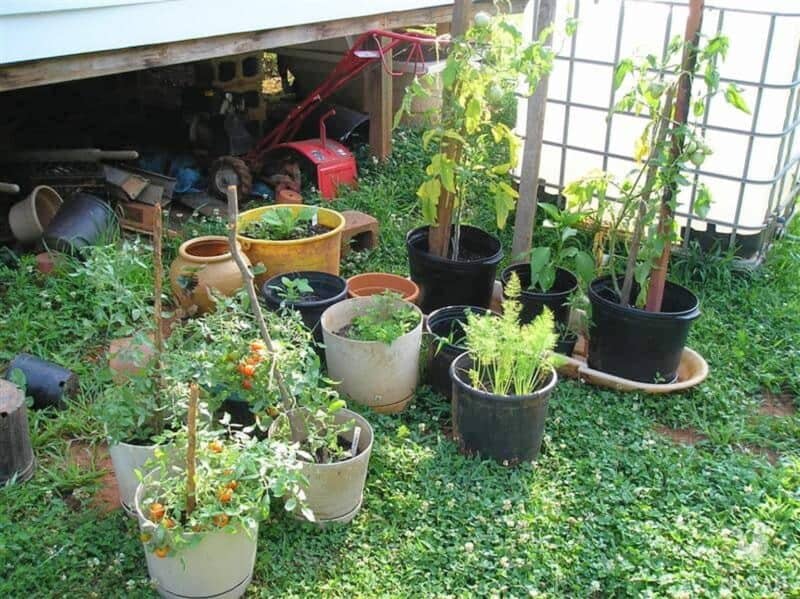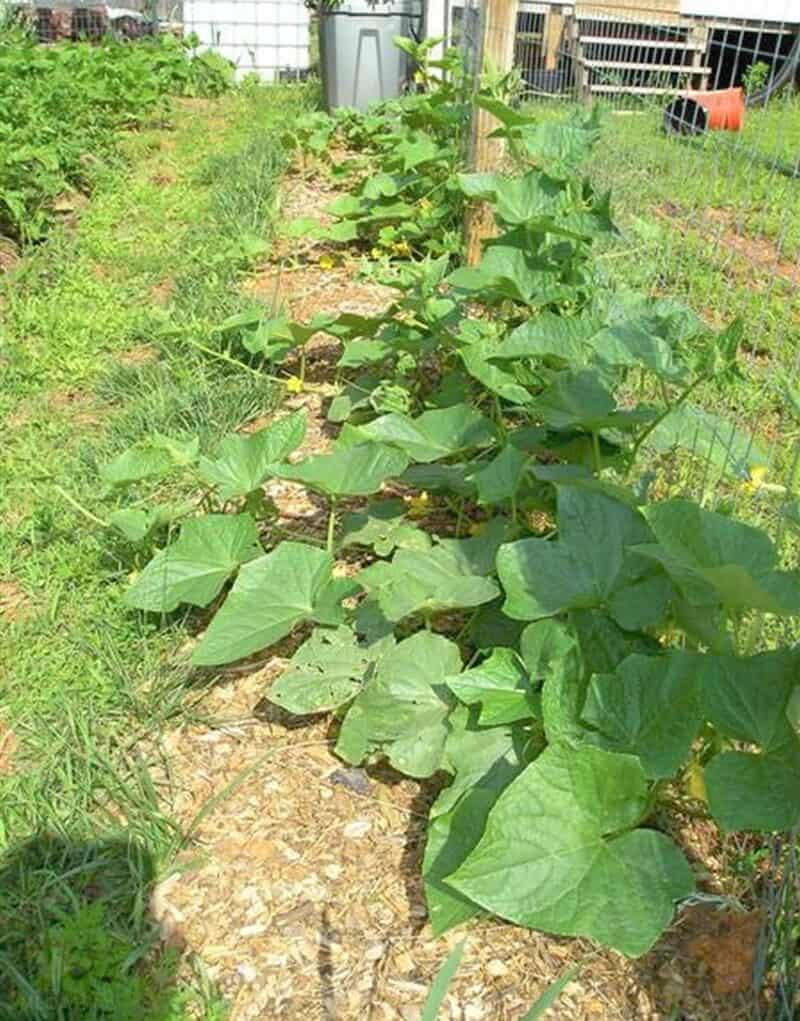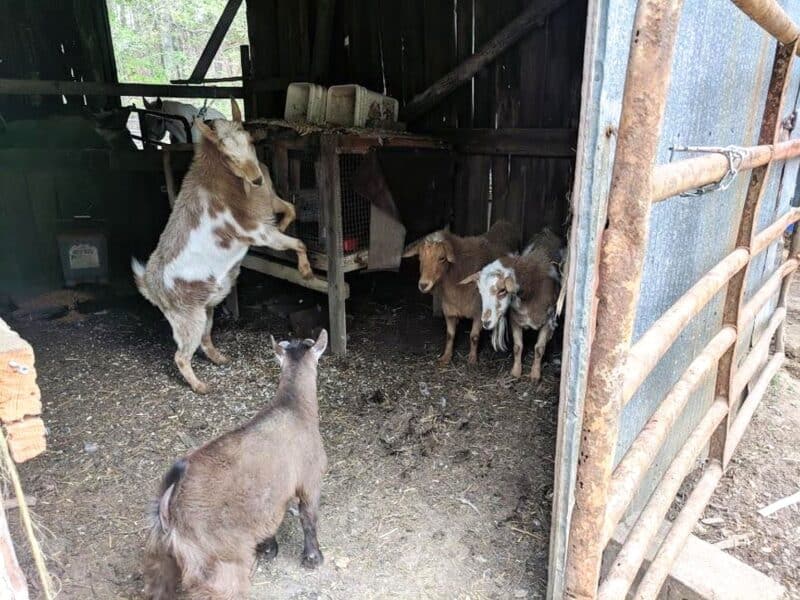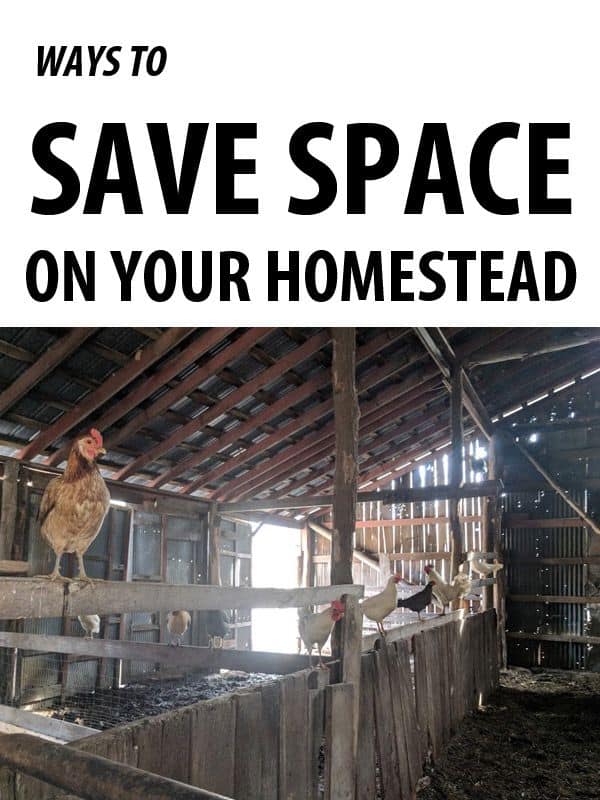When it comes to gardening on your homestead there are many great and fun ways to save space. You don’t have to spend a fortune and you can mix and match these ideas to work for your gardens in and around your homestead.
On our homestead, we use a combination of these ideas in and around our house and have found that it’s fun and exciting to mix and match them. Even the kids have become involved and what one doesn’t think of, the other will.
Many plants lend themselves better to one form of gardening over another. So we’ve devised our own system to plant our garden and utilize as much space as possible. It’s fun and the kids love having their own specialty areas to garden in.
Vertical Gardening
Perhaps the most common form of space saving gardening is that of vertical gardening. Here the gardener will use any of the below means to build their garden vertically. It’s fun and creative and the kids really enjoy watching their plants climb taller. In fact, they often have competitions to see whose plants will get the tallest.
This means that they are out weeding their particular sections and tending lovingly to them to ensure that they will “win the competition”. I love it because I don’t have to weed those areas and the kids are tending to the garden and learning valuable gardening skills. We’ve listed a few ideas to get you started.
- Recycled Pallets (Lean them together as a teepee, secure two to one another, be creative)
- Trellis (if you have a few posts, you can create a trellis, there are many styles to choose from)
- Steel Mesh
- Shoe Organizers (these are really cheap at the dollar store hang them from fences, walls etc.)
- Recycled Gutters (again, hang them from a variety of locations)
- Old Ladders (simply stand them up and allow plants to climb them)
- Burlap Bags Hung From A Pergola
By mixing and matching any of these ideas ( or using another idea that you may have), you can plant garden plants that like to climb such as cucumbers, squash, cherry tomatoes, beans, peas, and any other plants that normally require some form of support to climb.
These vertical gardens can stand on their own, or you may wish to put them on the side of a building or with some other form of support. Either way, you’re sure to expand your gardening space when you utilize some vertical space for climbing plants. You can also make a great privacy area by planting some near a patio or deck.
Stacked Tires
While this one is rather controversial, we’ve used it for years. We plant potatoes in tires that are stacked 3 high. We simply put enough dirt in the bottom of the first tire and plant five to six potatoes in the tire. We then stack the next tire on and repeat the process until we are three tires high. You could add more tires if you wish, it’s all up to you. We then water from the top down and when the potato plants flower and then the flowers die, we know it’s about time to harvest our potatoes.
Many people prefer to wait to fill the second tire until they see that the first tire has sprouts coming up. We don’t do it this way, but if desired, you could do it this way too. There really is no right or wrong way to do it, it’s all up to you, the gardener/homesteader.
To harvest our potatoes, we simply push the tires over and gently dig through the dirt with our fingers gently removing the potatoes. Allow potatoes to dry in the sun for one afternoon and then brush the dried dirt from your potatoes. Never wash potatoes as this could start them rooting again or cause rot. Store your potatoes in a dark cool root cellar and remove as many as you need for each meal.
We’ve also had success planting tomatoes, squash, and bush beans in tires. The tires keep the plants warmer longer so, in a sense, they extend your growing season. You can also cover them with vinyl or greenhouse plastic if it’s going to frost and help protect them using the tire for a support.
Note: There is a bit of controversy over using tires as the rubber may emit chemicals when it’s really hot outside. We’ve used tires for years with no issues but if you have someone who is very sensitive to chemicals in your family you may wish to reconsider this option.
Container Gardening
Not all areas are conducive to gardening. Some may require major soil amendments and others may simply be on a hillside or other location that simply isn’t suitable for gardening. In such cases, containers are an ideal solution.
You can plant any type of plant in containers if the containers are large enough. From tomatoes to potatoes to peppers, peas, beans, greens and other plants you can plant in a variety of containers.

Utilize different sizes and focus on being able to relocate them as required to take advantage of the sun, shade and watering situation.
We have radishes and tomatoes planted in containers and have set them into a rock garden that we have. As required (according to the temperature) we will move them around so that they aren’t too hot in the summer heat. We water them as needed and have a great crop of radishes and tomatoes annually.
You could also use containers on your front porch, steps, on a walkway, down a driveway, on a ledge or underneath of trees that offer shade. The possibilities are endless and you’ll come up with a great variety of ways to use them in and around your homestead.
Even a 5 gallon bucket works well in a pinch. You can also use old pans that may leak, old washtubs (the best potatoes we ever had were in a compost pile that my son started in an old washtub.
He put potato peelings in there one night and a few weeks later he was turning the compost when he spotted potatoes growing. We had huge potatoes that year.
A friend of ours threw old squash and gourds into her compost pile and never gave it a through, until they were turning the compost late fall and out came gourds. She filled 6 five gallon buckets with gourds and was giving them away that fall.
Raised Beds
These are ideal for the elderly, disabled, and anyone who has either poor soil or a bad back. Build your garden beds up off of the ground and you can save your back and even someone in a wheel chair can garden in such beds if you build them the right height.
You could build a foundation with 2X4’s and then use pallets on top of them and build up some sides. It’s all up to you how you do it, but it’s an excellent way to save your back and for the elderly and disabled to be able to garden.
As an added bonus, raised garden beds will stay warmer longer and are less likely to freeze when the ground freezes so you’re sure to extend your gardening season and be able to enjoy fresh fruits and vegetables longer.
Keyhole Gardening
This is an alternate version of a raised garden bed. You simply picture the old-fashioned keys that used to open the old-fashioned wooden doors. The idea here is that you set up your raised garden bed in the shape or design that best suits you so that you don’t have to move to reach the various areas of the garden bed.
Picture your arms outstretched and what you can reach from any given position. Now design your garden in that shape. It works well especially for anyone who struggles with limited motion. You could even build the garden in a “U” shape or a “V” shape. Be creative and let your imagination take you away.
Hydroponic Gardening
Some homesteaders struggle with areas that are too wet. There is a solution, hydroponic gardening will work in many of these areas. We haven’t tried this one on our homestead but I have some friends that had an old pond bed on their property so they allowed the pond to settle back in by opening up a dammed up area and they got a few koi fish. They then planted some plants that basically floated on the water and allowed the fish to nourish the garden with their poop which acts as fertilizer.
They feed the fish periodically and the pond does the rest of the work. They don’t do this on a large scale, but it works well for a few things and they seem very happy with it.
Layering or Lasagna Gardening
This is another one that works well if you have poor soil. Simply throw down some straw and compost and then plant some of your seedlings. Layer more of your straw or some soil over the area as the plants grow up through the other layers. Repeat your layers as required.
An alternate method here would be straw bale gardening which works well because you actually plant the seedlings into a bale of straw. You’ll want to water it well and make sure that you pluck out any weeds that may have decided a straw bale is an ideal location as well. You can get a few things growing this way and have a nice garden.
Square Space Gardening
This is a simple way to garden and can be done directly on the ground, or in a raised bed. The idea here is to portion it out in square feet. In each square foot you plant your seedlings leaving a bit of space for them to grow, but not enough for weeds. Keep an eye on it and don’t let weeds grow. This is an easy one to weed because each section is only one square foot.
This is ideal to do in a variety of locations in your yard and will help you to use the best sun for any given plant area. You can put a few together if you wish but make sure that you can stand in one spot and reach all of the square space.
That’s the beauty if this method. It’s very similar to micro-gardening in that you plant a large quantity of the seedlings into one small space choking out anything else.
Many will thin out the plants that aren’t doing as well so that those that are doing well can fill in the space quickly. It’s an ideal way to use small areas if you have an irregularly shaped yard or garden space.
Companion Planting
A lot of people think that companion planting is folklore rather than practical, however, we’ve found that when we plant marigolds with our tomatoes (as a fine example) the bugs leave our tomatoes alone. So we’ve included this for you to decide. Here is a short list of ideas for companion planting, there are many more plants that work well together:
- Borage
- Tomatoes
- Marigolds and Calendula (different but often confused for one another)
- Chives
- Garlic
- Carrots
- Basil
- Peppers
- Sage
- Nasturtiums
- Lettuce
All of the above-mentioned plants work very well together. Another idea is to plant climbing plants with corn and allow the climbers to climb the corn stalk.
This saves space and gives you two crops in the space that would normally give you only one crop. It’s amazing how much space you can save when you use methods like this to utilize space on your homestead.
Put plants that require more water in one grouping. This works well whether you’re container planting or square foot planting or however you choose to garden. That way, you can set the water system up so that you won’t have to over water something that requires less water.
Don’t forget that many plants require pollinating. Be sure that you have some plants that will work well for this such as flowering plants that will draw in your bees for pollination.
Some plants will naturally pollinate via the wind or weather while others will rely heavily upon the bees doing their job to pollinate.
Convenience or Potager Gardening
My grandmother had what she referred to as a potager or potage garden. This was a small garden area that was just off the kitchen. Here she grew such plants as basil, a variety of lettuces, some chives, and other greens that she would use often in her cooking.
There were other herbs here as well. I loved this garden as a child and would spend many an hour learning which plants flavored foods the best. I’m sure my grandmother just appreciated that I would pull some of the weeds while I was out there. Either way, it’s a great memory that left me with some great culinary skills.
She told me that the potage or potager garden was something that her mother had called this particular location of a garden and that it was planted close to the kitchen so that the cook could walk right out to the garden and gather salad fixings for dinner.
We never complained and the food was always fresh. Just grab the kitchen shears and go snip what is needed for that meal, you don’t have to worry about storing it during the warmer months and in the cooler months you can dehydrate many of the herbs and enjoy them throughout the year.
Things To Consider
When planting your garden, there are a few things to consider and some important questions to ask yourself. Here are a few things you’ll want to consider and think about when deciding what sort of ways to use your garden space. Ask yourself these questions and really think about the answers so that you’ll make the best use of your space.
- How much garden can you successfully handle?
Will you be canning, dehydrating and freezing? Or will you just be using what is in season? If you’re going to be canning, dehydrating and freezing, you’ll want to make sure that you plant accordingly so that you’ll have plenty of excess to process and save for the winter months.
Another thing to consider is whether you’ll be doing the planting, weeding, and harvesting alone, or if you’ll have help from the family. If you’re going to have help, you can go a bit bigger than if you’re going to be doing all of the work yourself.
- What foods does my family like?
If no one in your family likes okra or eggplant, then there is no point in planting a lot of it, if any at all. If you like some, but not a lot, plant 2 plants so that they can pollinate one another and then use the rest of the space for food that the entire family enjoys. This results in better use of your garden space, and fewer complaints at the dinner table from those who wouldn’t dream of tasting fried okra or eggplant.
- How much space will you require?
If you’re planting a lot of plants that like to sprawl out and take up space such as squash and cucumbers, going vertical is going to save a lot of space, and allow you to plant more.

Consider how much space your garden will require for the number of foods you’re going to be planting. You can always add to the size of your garden next year and the year after. Starting small and going larger is a great way to break yourself into gardening.
- Will I, or my family, be spending time out on the patio or my deck that has part of my garden on it?
If so, be sure that you plant some plants that will be pretty, offer a bit of privacy (if you’re near a busy road or other high traffic area) and that will smell good. This is also an ideal way to incorporate companion planting and some flowers into your garden area so that you’ll have pretty flowers to enjoy from your patio or deck.
This is also an ideal location to plant some plants that help to repel mosquitoes. This will help you to be able to enjoy your deck and patio more often in the warmer months.
- Will I succession plant?
Many plants, such as radishes, work best if you plant some, then wait 7 days or more and plant them again, that way, you always have fresh food coming on.
You can also plant one crop, and then after it’s harvested or as it is nearing harvest, plant another type of plant to take its place. This works well if you’re planting cold weather veggies and then warm weather veggies.
By focusing on what space you have and what works well for you, you can choose from the above ideas and create your own unique garden. Your garden doesn’t have to look like anyone else’s. It can look however you wish it to look.
Many people start small by focusing on one area each year until they have their entire garden designed and laid out. Those gorgeous gardens you see in magazines didn’t happen in just one season. They were cultivated and designed over many seasons and given the chance to grow and flourish.
This is what makes them so unique and spectacular. Enjoy your garden and focus on what makes you happy. Your friends and family will love your garden and the easier it is to handle your garden, the more compliments you’re going to be getting on how nice it really looks.
Don’t forget to add some flowers in here and there for contrast. There are many edible flowers and these look and taste great in salads.
Basements
Saving space in the basement is easier than ever when you incorporate some of these great ideas into the storage of your items that you would normally keep in the basement. Focus on built in cupboards or shelving units underneath of the stairs. There is a lot of space that is left unused in the basement and this is one of the most ignored areas.
Don’t forget that you can also utilize vertical space by hanging things on the walls that normally would be left on the floor. Consider hanging tools in a section, fishing gear in another section and so on so that you’re readily organized while still taking advantage of space.
If you’re using the basement as a family or guest room area you can still use it to hang things in by creating focal points for some of the items. Fishing gear, for example, would be fine hung in a guest room or in a family room.
Root Cellars
Storing your freshly gathered produce and canned goods in a root cellar is a great way to keep it in a cool dark place. Don’t forget that you can string up some rope, twine, or clothes line and hang dried herbs from this line. You can also mount a magnetic strip to an area and store spices in small sized jelly jars and then place them on the magnetic strip.
Don’t forget that you can have bins of insulating materials such as sawdust or newsprint to store root vegetables in. Just make sure that they remain clean and dry and you should be fine for a season. Many root cellars are earthen so they remain at an even temperature year around. Keeping vegetables in a cool dry place has long been done to store them for a season.
Inside Of The House
Many old farmhouses and homesteads have a laundry room that doubles as the pantry and the utility closet. This works well in our house. It’s also an ideal location to remove boots and shoes. There is a utility sink and a door to the outside here so it works well for our family.
On one wall, we have floor to ceiling shelves and keep jars and canned goods here. Items that are in bags are placed into plastic totes to prevent mice and then the lid is kept on. We have these labeled with a piece of masking tape so at a glance we know what each tote holds.
We keep boots and shoes in an old post office mail box section that we were lucky enough to find at a yard sale. There are about 28 mailboxes in the unit so it works well turned backwards as a cubby. Some of the boxes have their combinations and others don’t so by turning it backwards we were able to circumvent the storage issue of not having all of the combinations. It works for shoes, rolled up rags (we just roll some up like towels) and other smaller items that we need to keep track of, but don’t want to trip over.
We also have an old wooden wine rack back here that we found behind a grocery store. They were going to throw it out and after a brief conversation said we could have it. We toted it home and put it to good use. It’s rather eclectic looking and offers up more storage area that we love. It keeps with our old-fashioned look and fits our needs well.
Look around and find unique items that others are throwing out and you’re likely to find a variety of items that you can repurpose. Old ladders make ideal shelving units. Stack old suitcases on their sides according to size and you can have instant storage and a table for that lamp that you need by the corner but have nothing to set it on.
A small sized bathroom can often fit a small sized clothes basket or wicker basket in that you have rolled up towels in. Don’t forget you can mount baskets to walls in a variety of locations to store lightweight items such as towels or other things that are frequently used but you need to store.
Use small narrow totes for narrow spaces and don’t forget to use flatter sized totes for underneath of the bed, sofa, and some of the other furniture that will allow you to store things underneath of it. Consider adding in a pressure or tension rod in the shower and hang the shampoo and conditioner bottles from it. All you need are some “S” hooks and a few minor adjustments to the lids (you can buy special lids and just change them out or design your own).

In The Backyard
If you have a patio or deck in the backyard, keep it neat and tidy so that guests and family and friends can all enjoy it for relaxing.
Have a bin for toys that the kids use and keep them corralled in it when not in use. Opt for furnishings that allow for some storage in the bottom such as a seat that lifts out for storage on a small love seat or sofa styled piece of deck furniture.
Old cupboards painted to match other items on the deck will go far to hold citronella candles, bug spray, sunscreen and the like. Use solar lighting in and around the deck to keep the bugs away.
Some decks have trap doors that allow you to reach underneath and pull out extra folding chairs or other items that may not be used often but you wish to have accessible.
Use a small garden shed to store things in, design an old cupboard set to hold barbecue items and outdoor eating utensils and implements. You can then close it off when not in use.
Get hoses up off the ground with a variety of hose storage systems. You can buy one ready made, or look at them and create your own. Store sprinklers near the hoses and don’t forget a pet friendly area of your yard. It should have some shade, plenty of fresh water and an area for your pets to play safely.
Barn
Depending on the size and shape of your barn you’ll have many great opportunities for storage space. Remember that most barns have exposed rafters which make an ideal location to store extra fencing supplies and other supplies that may have poles or other long pieces to them.
You can also use smaller nooks and crannies by focusing on one area at a time and stacking things that aren’t used often in these areas. Keep similar items together and that way when you need them you’ll be able to find them easily.
Store all of the canning supplies, the cider press, and other similar items in one simple location. You may wish to build cupboards or use plastic totes to keep everything free of mouse droppings. Choose a location for gardening supplies and store implements such as rakes, hoes, shovels and the like here. We use an old barrel to stick all of these into for our barn and it works very well to keep things right where someone can find them.
Our barrel sits right in a corner and all of the implements are stuck in the barrel. The rule is that when you take one out, you put it back when you’re finished with it, that way, the next person can find it when they need it.
Fertilizer and other garden supplies are on an old shelving unit that came with the barn. We just stack them on there and that way we can see at a glance when we need to order more.


Hi, I’m Linda. I’m a mom, grandmother, homesteader. I love simple living and enjoy my life on a homestead where I garden, raise a variety of animals and strive for a life more like my grandparents lived.
My goal is to enrich life by living it as simply as possible and focusing on the way my grandparents did things. Life is so much more fun when it’s lived simply.

Linda you have a very interesting article , here really enjoyed read it , very helpful ideas , you are a wife now ?
Get those sodas away from those young men! No sugar needed at that age, unless a special treat.